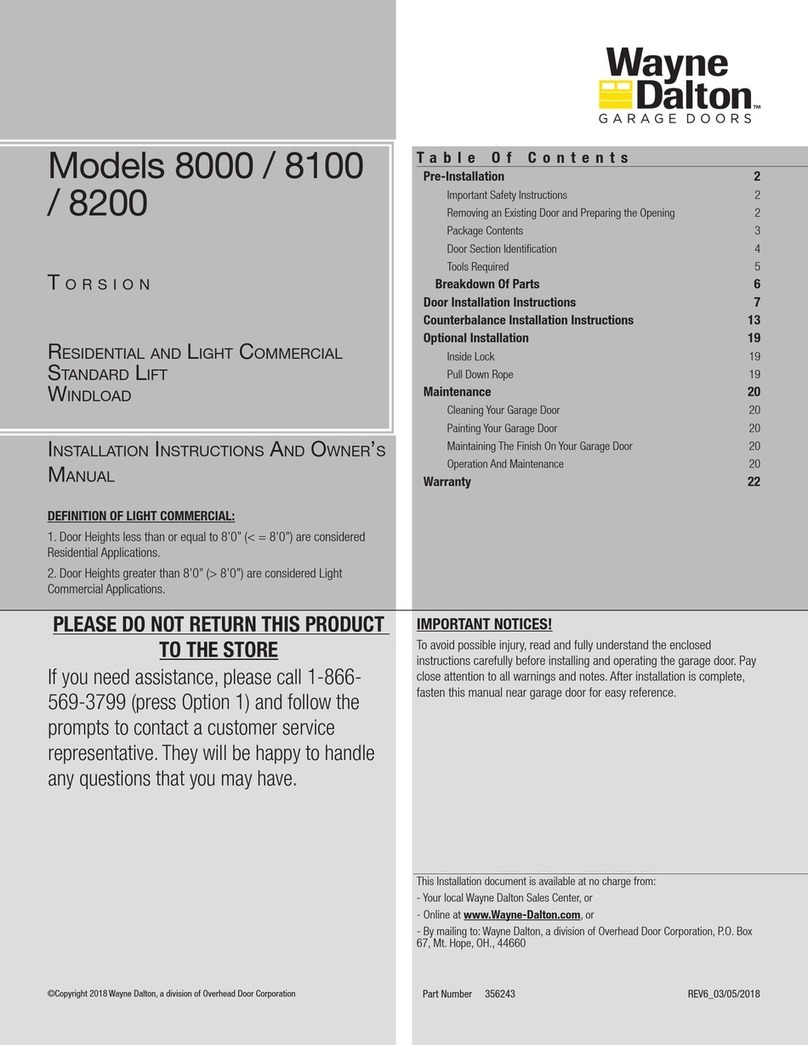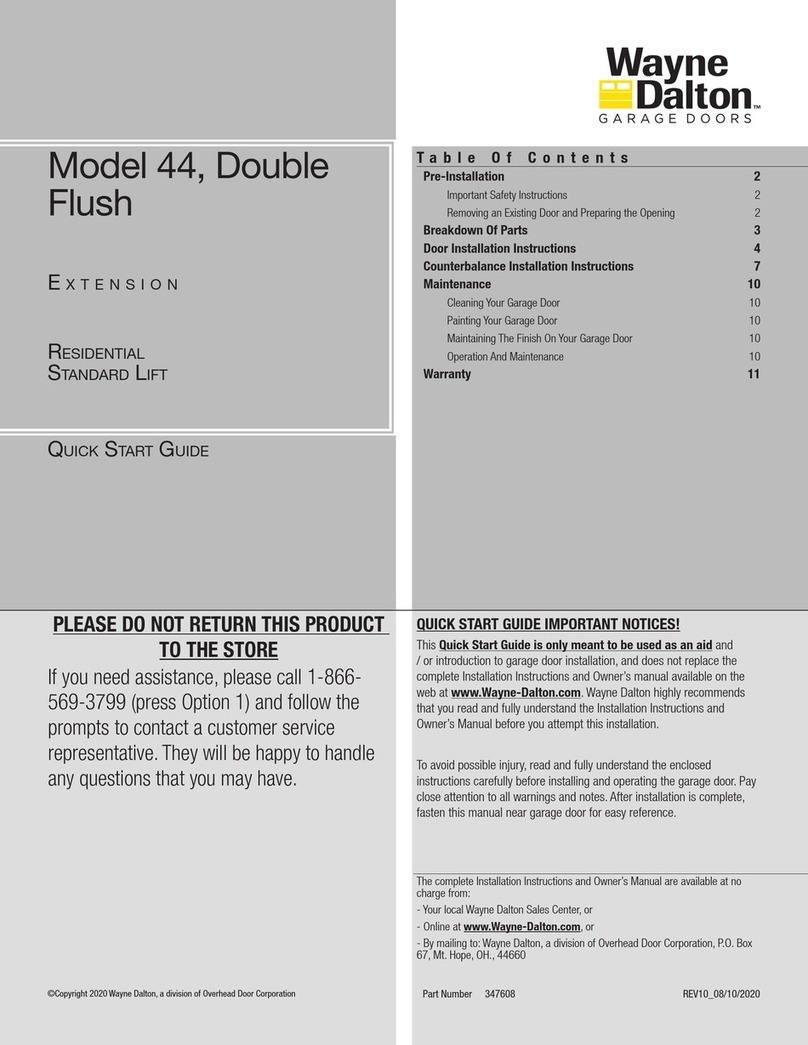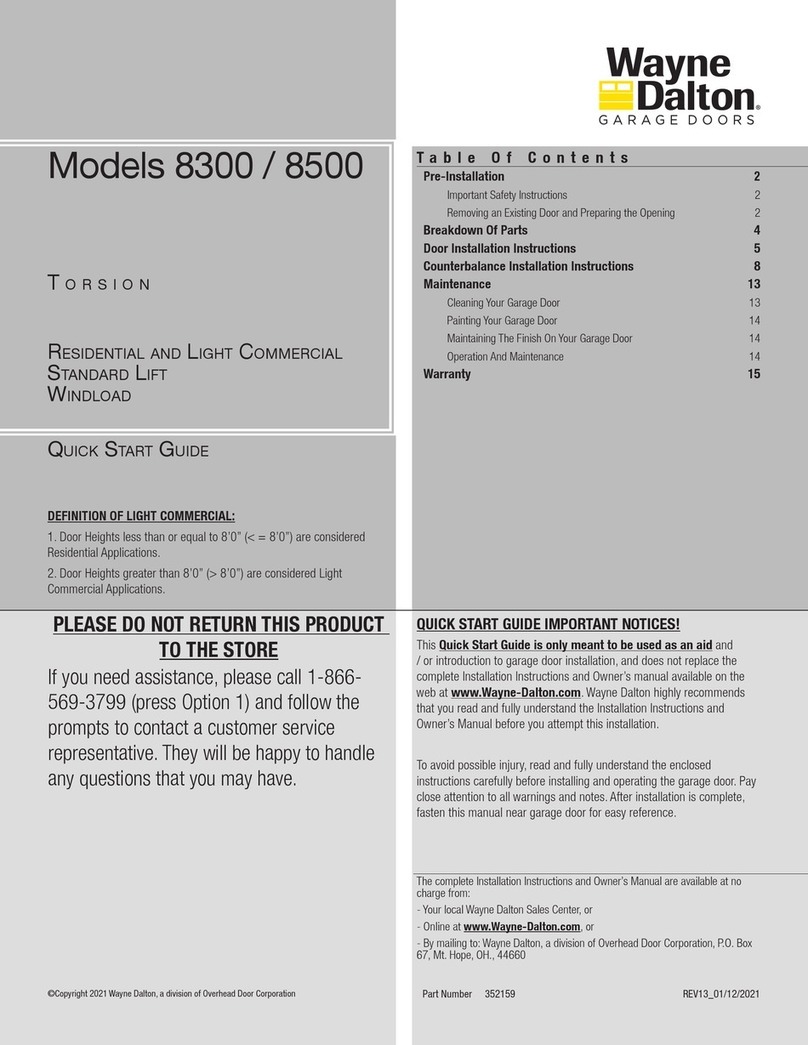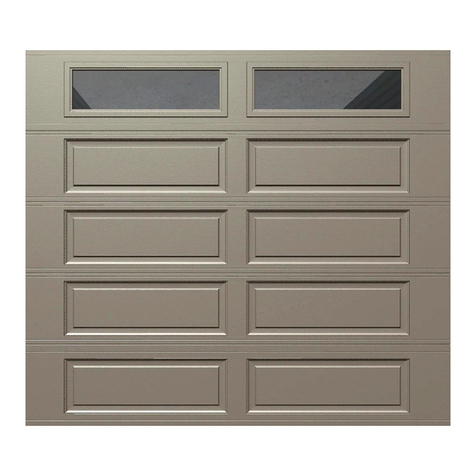
NOTE: The #4 graduated end hinges serves as end hinges on the Intermediate II section
(used only on the fourth section of a five section high door).
Starting on the left hand side of the bottom section, align the lower hinge leaf of the #1
graduated end hinge over the holes, located at the top of the end caps. Attach lower leaf to
the end caps with (2) 1/4” - 14 x 5/8” self tapping screws. Repeat for other side. Next, align
the lower hinge leaf of the #1 center hinges with the pre-punched holes at each center stile
location(s), located at the top of the bottom section. Attach lower hinge leaf to the center stile
with (2) 1/4” - 14 x 5/8” self tapping screws. Insert a short stem track roller into the hinge
tube of the #1 graduated end hinges.
IMPORTANT: ONCE THE 1/4” - 14 X 5/8” SELF TAPPING SCREWS ARE SNUG AGAINST THE
LOWER HINGE LEAFS, TIGHTEN AN ADDITIONAL 1/4 TO 1/2 TURN TO RECEIVE MAXIMUM
DESIGN HOLDING POWER.
Repeat graduated hinge attachment using the appropriate graduated end hinges for all
remaining sections except the top section.
IMPORTANT: WHEN PLACING SHORT STEM TRACK ROLLERS INTO THE #2 GRADUATED
END HINGES AND HIGHER, THE SHORT STEM TRACK ROLLER GOES INTO HINGE TUBE
FURTHEST AWAY FROM SECTION.
IMPORTANT: ONCE THE 1/4” - 14 X 5/8” SELF TAPPING SCREW IS SNUG AGAINST THE
LOWER HINGE LEAF, TIGHTEN AN ADDITIONAL 1/4 TO 1/2 TURN TO RECEIVE MAXIMUM
DESIGN HOLDING POWER.
Strut (U-Shaped)
Tools Required: Power Drill, 7/16” Socket driver, Tape measure, Level, Safety
glasses, Leather gloves
7
NOTE: Refer to door section identification, located in the pre-installation section of this
manual or refer to Parts Breakdown.
Using the strut schedule, determine the placement of the struts for your door width and door
height.
INSTALLATION ON THE TOP SECTION:
Locate and center the strut at the top of the top section surface. Secure strut to top section
using (2) 1/4” - 20 x 7/8” self drilling screws at each end and at each center stile locations.
INSTALLATION ON ALL OTHER SECTIONS:
NOTE: All struts are placed at the top of the sections and up against the bottom of the gradu-
ated hinges, for the intermediate, lock and bottom sections.
Locate and center the strut onto the section surface and up against the bottom of the hinges.
Center the strut side to side. Secure strut to the section using (2) 1/4” - 20 x 7/8” self drilling
screws at each end and center stile locations.
Strut Schedule
Door Width 4 Section High Door 5 Section High Door
8’0” – 13’11” N/A N/A
14’0” – 16’0” (1) Strut Top Section (2) Struts Top and Bottom
Sections
16’1” – 18’0” (3) Struts Top, Lock and Bottom
Sections
(3) Struts Top, Intermediate I
and Bottom Section
18’1” – 20’00” (4) Struts All Sections (5) Struts, All Sections
Top Fixtures
Tools Required: Power Drill, 7/16” Socket driver, Tape measure, Level, Safety
glasses, Leather gloves
8
Align the upper-center hole of top fixture base with the hole in the end stile of the top section,
as shown. Ensure the top fixture base is level and aligned with edge of the top section. Se-
cure with (4) 1/4” - 20 x 7/8” self drilling screws, one in each corner of the top fixture base.
Insert short stem track roller into top fixture slide. Repeat for other side.
NOTE: If needed, ensure the top fixture slides are able to slide back and forth along the top
fixture bases. If needed, loosen the (2) 1/4” - 20 flange hex nuts.
Cable Drum Assemblies and Track Rollers
Tools Required: Power Drill, 7/16” Socket driver, Tape measure, Level, Safety
glasses, Leather gloves
9
NOTE: Refer to door section identification, located in the pre-installation section of this
manual or refer to Parts Breakdown.
Starting on the left hand side, attach left hand bottom corner bracket to the left corner of the
bottom section, making sure it is seated to the edges of the end cap, using (2) 1/4” - 20 x
11/16” self drilling screws (1) 1/4” - 20 x 5/8” tamper resistant screw. Repeat for other side.
NOTE: Only doors provided to professional installers, who have the required tools will be sup-
plied with a tamper-resistant fastener. Use a 1/4” - 20 x 11/16” self drilling screw in bottom
bracket, if not provided with a tamper-resistant screw.
NOTE: Cable drum assemblies are marked right and left hand.
WARNINGWARNING
FAILURE TO ENSURE TIGHT FIT OF CABLE LOOP OVER MILFORD PIN
COULD RESULT IN COUNTERBALANCE LIFT CABLE COMING OFF THE PIN,
ALLOWING THE DOOR TO FALL, POSSIBLY RESULTING IN SEVERE OR
FATAL INJURY.
Uncoil the counterbalance lift cables from the cable drum assemblies, making sure you place
the left hand cable loop on the left hand milford pin of the bottom corner bracket and the
right hand cable loop on the right hand milford pin of the bottom corner bracket.
NOTE: Check to ensure cable loops fits tightly over the milford pins.
Insert a short stem track roller with a roller spacer into each of the bottom corner brackets.
NOTE: Larger doors will use long stem track rollers with double graduated end hinges.
NOTE: Verify bottom weather seal is aligned with bottom section. If there is more than 1/2”
excess weather seal on either side, trim weather seal even with bottom section.
Step Plate
Tools Required: Power Drill, 5/16”/7/16” Drill bits, 1/4” Wrench, Tape measure,
Phillips head screwdriver, Level, Safety glasses, Leather gloves
10
NOTE: Depending on your door, you may have two different kinds of Step Plates or two of the
same kind of Step Plates. Refer to Package Contents, to determine which Step Plates you
have.
IF YOU HAVE TWO OF THE SAME KINDS OF STEP PLATES:
Locate the center most center stile of the bottom section of the door. On the inside of the
door, center the step plate on the center most stile no higher than 6” from the bottom of
the door. Using the step plate holes as a template, drill a 5/16” dia. hole along each side of
the center stile, through the face of the door. Drill through insulation and door’s face on an
insulated door.
IMPORTANT: BE EXTREMELY CAREFUL TO KEEP DRILL STRAIGHT.
Mount the inside step plate and the outside step plate back to back, straddling the center
stile. Secure with (2) 1/4” - 20 x 2-3/4” carriage bolts and 1/4” - 20 hex nuts.
IMPORTANT: DO NOT MOUNT THE STEP PLATE HIGHER THAN 6” FROM THE BOTTOM OF
THE SECTION.
IF YOU HAVE TWO DIFFERENT KINDS OF STEP PLATES:
Locate the center most center stile on the bottom section of the door. On the inside of the
door and using the pre-punched holes at the bottom of the center stile as a template, drill (2)
7/32” dia. holes through the section. Using the previously drilled holes as a guide, enlarge
the holes from outside the door to 7/16” dia. and assemble the outside and inside step plates
to the section using (2) #8 x 1-5/8” screws.
NOTE: Do not drill through or enlarge holes on the inside of the door.
NOTE: After completing this step, continue with Step Lift Handles.
Lift Handle
Tools Required: Power Drill, 9/32”/1/2” Drill bits, 1/4” Wrench, Tape measure,
Phillips head screwdriver, Level, Safety glasses, Leather gloves
11
NOTE: Doors with a Keyed lock do not require this lift handle.
Locate the inside center stile or the desired lift handle location on the lock (2nd) section
of the door. Position the lower hole in the lift handle 4” from the bottom of the lock (2nd)
section.
IMPORTANT: THE DISTANCE BETWEEN THE STEP PLATE AND THE MIDDLE OF THE LIFT
HANDLE MUST BE 20” MINIMUM TO 30” MAXIMUM. IF NECESSARY REPOSITION THE UPPER
LIFT HANDLE TO STAY WITHIN THE REQUIRED DIMENSION.
Using the lift handle holes as a template, drill (2) 9/32” dia. holes through the lock section.
Enlarge the holes from the outside the door to 1/2” dia.
NOTE: Do not drill through or enlarge holes on the inside of the door.
Assemble the outside and inside lift handles to the lock section using (2) spacers, (2) 1/4” -
20 x 2-1/2” carriage bolts and (2) 1/4” - 20 hex nuts.
Bottom Section
Tools Required: Tape measure, Level, Wooden shims (if necessary), Safety
glasses, Leather gloves
12
Center the bottom section in the door opening. Level the section using wooden shims (if
necessary) under the bottom section. When the bottom section is leveled, temporarily hold it
in place by driving a nail into the jamb and bending it over the edge of the bottom section on
both sides.
Vertical Tracks
Tools Required: Power Drill, 3/16” Drill bit, 7/16” Socket driver, Tape measure,
Level, Step ladder, Safety glasses, Leather gloves
13
NOTE: Depending on your door, you may have Quick Install Flag Angles, Fully Adjustable Flag
Angles or you may have Riveted Vertical Track Assemblies. Refer to Package Contents / Parts
Breakdown, to determine which Flag Angles / Vertical Track Assemblies you have.
IMPORTANT: IF YOUR DOOR IS TO BE INSTALLED PRIOR TO A FINISHING CONSTRUCTION
5
































